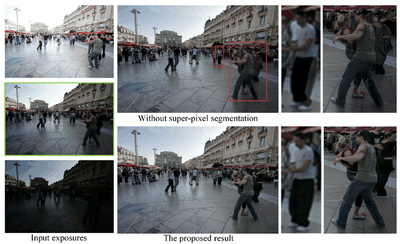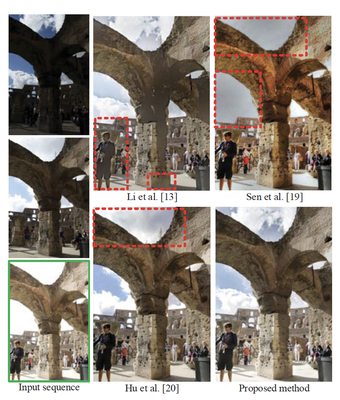High Dynamic Range Imaging

1. Motion-free exposure fusion based on inter-consistency and intra-consistency
- Algorithm:
Given differently exposed images, we intend to create a high-quality tone mapped-like HDR image where no ghosts are present using exposure fusion. As illustrated in the above figure, the proposed method is composed of the following steps.
First, for inter-consistency, a histogram-based matching algorithm is employed to create normalized versions of the chosen reference image I_r with respect to each exposure I_i in the image stack. Thus, a normalized image I_ri is created that is exposed like the l_i, but shares the same contents as I_r.
Second, the pixels are grouped into super-pixels, by comparing the similarities between each pixel and its neighbors, and motion detection is performed at the super-pixel level to enforce the intra-consistency within each exposure. An intermediate latent image I_Li is produced by integrating the static contents in I_i and the dynamic contents in I_ri. Hence, all of the generated latent images are consistent in their content (the same as I_r), and contain no object movement. The final ghost-free result can easily be produced in a static weighted fusion manner, by preserving all of the details in the latent images.
- Experiment results:


2. Exploiting Patch-based Correlation for Ghost Removal in Exposure Fusion
- Algorithm:

As shown in the above figure, this method works by first selecting one of the input images in which the objects of interest perform best as the reference image. In order to detect the motion regions inconsistent with those of the reference image, the patch-based correlation is estimated to evaluate the structural similarity between the reference image and the other images in the input sequence.
Then, a series of binary consistency score maps are obtained. To keep the details of the latent images as much as possible, that is to preserve the pixels with good exposedness together to create a more informative image. A contrast quality measurement is introduced to generate a stack of corresponding weighting maps. Given the weighting maps, a tone mapped-like HDR image is generated by seamlessly compositing the latent images based on a multiresolution scheme.
- Experiment results
